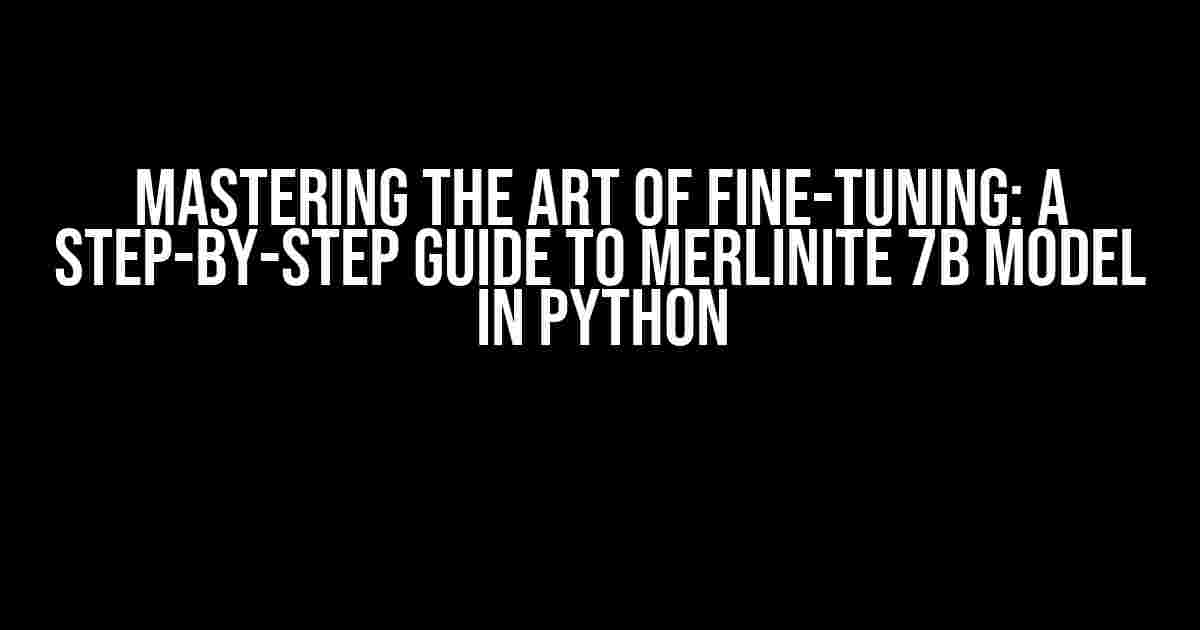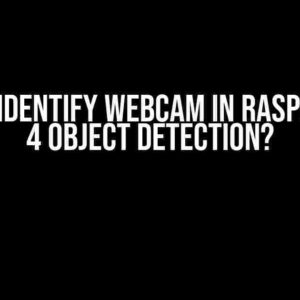Welcome, fellow data enthusiasts! Are you tired of mediocre model performance and ready to take your natural language processing (NLP) skills to the next level? Look no further! In this comprehensive guide, we’ll dive into the world of fine-tuning Merlinite 7B models in Python, and by the end of it, you’ll be a master of refining these powerful language models.
What is Merlinite 7B, and Why Do I Need to Fine-Tune It?
Merlinite 7B is a pre-trained language model that has taken the NLP community by storm. Its ability to understand and generate human-like language has made it a go-to choice for a wide range of applications, from chatbots to language translation. However, as amazing as Merlinite 7B is, it’s not perfect. Its pre-trained weights are based on a massive dataset, but they might not be optimized for your specific use case. This is where fine-tuning comes in – a process that allows you to adapt the model to your specific needs and significantly improve its performance.
Prerequisites: Get Your Python Environment Ready
Before we dive into the fine-tuning process, make sure you have the following installed:
- Python 3.7 or higher
- The Hugging Face Transformers library (
transformers) - The PyTorch library (
torch) - A GPU with at least 8 GB of VRAM (optional but highly recommended)
Step 1: Load the Merlinite 7B Model and Prepare Your Data
Let’s start by loading the Merlinite 7B model and preparing our dataset. We’ll use the Hugging Face Transformers library to load the model, and assume you have a CSV file containing your dataset.
import pandas as pd
import torch
from transformers import MerliniteForSequenceClassification, MerliniteTokenizer
# Load the dataset
df = pd.read_csv('your_dataset.csv')
# Load the Merlinite 7B model and tokenizer
model = MerliniteForSequenceClassification.from_pretrained('merlinite-7b')
tokenizer = MerliniteTokenizer.from_pretrained('merlinite-7b')Step 1.1: Preprocess Your Data
Preprocessing is a crucial step in fine-tuning any language model. We’ll use the MerliniteTokenizer to encode our dataset and create the input IDs, attention masks, and labels.
max_length = 512
batch_size = 16
# Create a function to preprocess the data
def preprocess_data(batch):
inputs = tokenizer(batch['text'],
max_length=max_length,
padding='max_length',
truncation=True,
return_attention_mask=True,
return_tensors='pt')
labels = torch.tensor(batch['label'])
return inputs, labels
# Preprocess the dataset
dataset = df.apply(preprocess_data, axis=1)Step 2: Create a Custom Dataset Class and DataLoader
To fine-tune the Merlinite 7B model, we need to create a custom dataset class and DataLoader. This will allow us to feed our preprocessed data to the model during training.
class MerliniteDataset(torch.utils.data.Dataset):
def __init__(self, dataset, tokenizer, max_length):
self.dataset = dataset
self.tokenizer = tokenizer
self.max_length = max_length
def __len__(self):
return len(self.dataset)
def __getitem__(self, idx):
inputs, labels = self.dataset.iloc[idx]
return {
'input_ids': inputs['input_ids'].flatten(),
'attention_mask': inputs['attention_mask'].flatten(),
'labels': labels
}
# Create the custom dataset and DataLoader
dataset = MerliniteDataset(dataset, tokenizer, max_length)
data_loader = torch.utils.data.DataLoader(dataset, batch_size=batch_size, shuffle=True)Step 3: Fine-Tune the Merlinite 7B Model
Now it’s time to fine-tune the Merlinite 7B model using our custom dataset and DataLoader. We’ll define a simple training loop and use the Adam optimizer with a learning rate of 1e-5.
# Define the device (GPU or CPU)
device = torch.device('cuda' if torch.cuda.is_available() else 'cpu')
# Move the model to the device
model.to(device)
# Define the optimizer and loss function
optimizer = torch.optim.Adam(model.parameters(), lr=1e-5)
loss_fn = torch.nn.CrossEntropyLoss()
# Train the model
for epoch in range(5):
model.train()
total_loss = 0
for batch in data_loader:
input_ids = batch['input_ids'].to(device)
attention_mask = batch['attention_mask'].to(device)
labels = batch['labels'].to(device)
optimizer.zero_grad()
outputs = model(input_ids, attention_mask=attention_mask, labels=labels)
loss = loss_fn(outputs, labels)
loss.backward()
optimizer.step()
total_loss += loss.item()
print(f'Epoch {epoch+1}, Loss: {total_loss / len(data_loader)}')
model.eval()Step 4: Evaluate and Save the Fine-Tuned Model
After fine-tuning the Merlinite 7B model, let’s evaluate its performance on a validation set and save the model for future use.
# Evaluate the model on a validation set
val_data_loader = torch.utils.data.DataLoader(val_dataset, batch_size=batch_size, shuffle=False)
total_correct = 0
with torch.no_grad():
for batch in val_data_loader:
input_ids = batch['input_ids'].to(device)
attention_mask = batch['attention_mask'].to(device)
labels = batch['labels'].to(device)
outputs = model(input_ids, attention_mask=attention_mask, labels=labels)
logits = outputs.logits
_, predicted = torch.max(logits, dim=1)
total_correct += (predicted == labels).sum().item()
accuracy = total_correct / len(val_dataset)
print(f'Validation Accuracy: {accuracy:.4f}')
# Save the fine-tuned model
torch.save(model.state_dict(), 'fine_tuned_merlinite_7b.pth')Conclusion
Congratulations! You’ve successfully fine-tuned the Merlinite 7B model in Python using the Hugging Face Transformers library. By following these steps, you should be able to improve the performance of the model on your specific use case. Remember to experiment with different hyperparameters, such as the learning rate, batch size, and number of epochs, to further optimize your model.
| Keyword | Definition |
|---|---|
| Fine-tuning | The process of adapting a pre-trained language model to a specific task or dataset. |
| Merlinite 7B | A pre-trained language model that has achieved state-of-the-art results in various NLP tasks. |
| Hugging Face Transformers | A popular Python library for natural language processing that provides pre-trained models and a simple interface for fine-tuning. |
By mastering the art of fine-tuning Merlinite 7B models in Python, you’ll be able to unlock the full potential of these powerful language models and take your NLP skills to the next level. Happy fine-tuning!
Frequently Asked Question
Fine-tuning Merlinite 7B model in Python can be a breeze with the right guidance. Here are some frequently asked questions to get you started!
What are the prerequisites for fine-tuning Merlinite 7B model in Python?
Before you begin fine-tuning the Merlinite 7B model, make sure you have Python 3.6 or later installed, along with the Hugging Face Transformers library. You’ll also need to have a GPU with at least 16 GB of VRAM to handle the model’s parameters. Finally, you’ll need a dataset to fine-tune the model on – the more data, the merrier!
How do I load the Merlinite 7B model in Python?
Loading the Merlinite 7B model in Python is a piece of cake! Simply install the Hugging Face Transformers library using pip (`pip install transformers`), and then import the `AutoModelForSequenceClassification` class. From there, you can load the model using the `from_pretrained` method, specifying the `merlinite-7b` model name. For example: `model = AutoModelForSequenceClassification.from_pretrained(‘merlinite-7b’)`.
What are some common hyperparameters to tune for the Merlinite 7B model?
When fine-tuning the Merlinite 7B model, you’ll want to experiment with hyperparameters like the learning rate, batch size, and number of epochs. You may also want to try different optimizers, such as Adam or SGD, and adjust the warmup steps and weight decay. Don’t be afraid to get creative and try out different combinations to find what works best for your specific use case!
How do I prepare my dataset for fine-tuning the Merlinite 7B model?
To prepare your dataset for fine-tuning, you’ll need to tokenize your text data using the `AutoTokenizer` class from the Hugging Face library. Make sure to specify the `max_length` and `truncation` arguments to handle sequences of varying lengths. You may also want to experiment with different preprocessing techniques, such as token masking or data augmentation, to enhance your model’s performance.
How do I evaluate the fine-tuned Merlinite 7B model on my test dataset?
To evaluate your fine-tuned model, you can use metrics like accuracy, F1-score, or ROUGE score, depending on your specific task. Simply pass your test dataset through the model, and calculate the desired metrics using a library like scikit-learn or nltk. You can also use the `evaluate` method from the Hugging Face library to get a comprehensive evaluation report.


